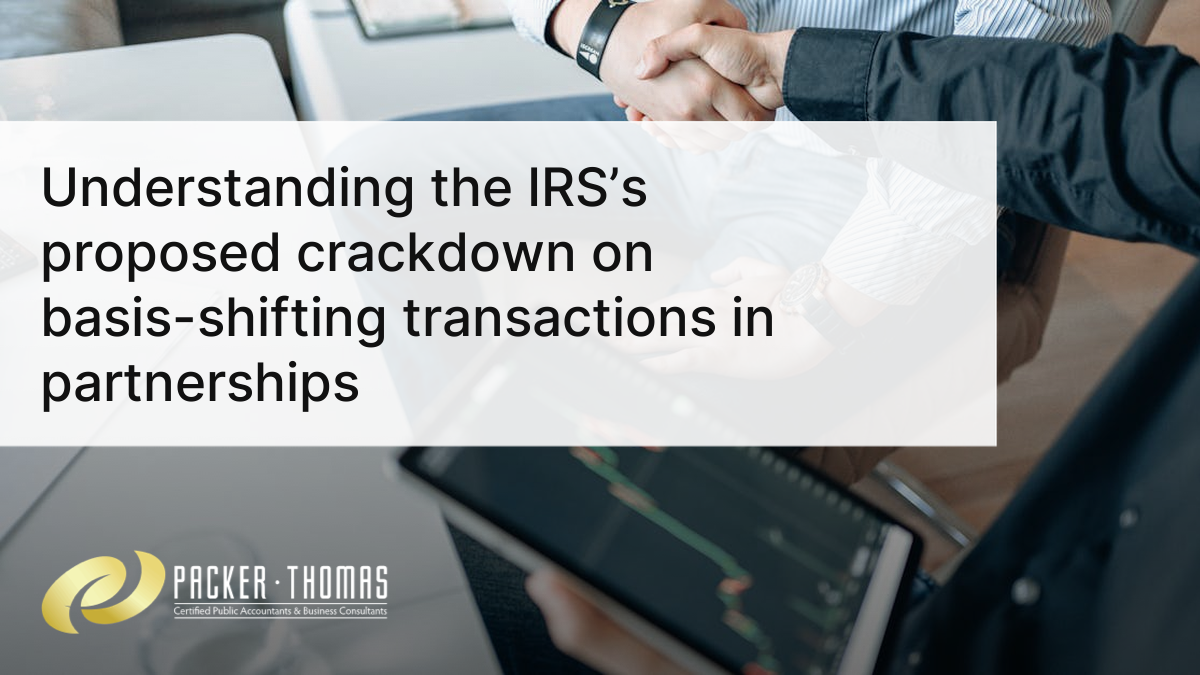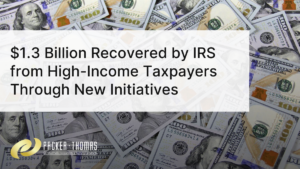Executive Summary
The IRS has issued proposed regulations aimed at curbing basis-shifting transactions in partnerships, which are designed to exploit tax rules for reducing liabilities. These transactions allow partners to artificially adjust asset values, creating significant tax benefits without corresponding economic investments. While the new rules specifically target abusive practices, their broad scope could unintentionally affect many partnerships, even those not seeking to avoid taxes. Although these regulations are not yet final and may undergo revisions, partnerships should review their transactions and engage with tax advisors to understand potential compliance risks and prepare for future changes.
Understanding the IRS’s proposed crackdown on basis-shifting transactions in partnerships
The IRS has released proposed regulations targeting basis-shifting transactions used by partnerships. While the rules are intended to curb highly sophisticated basis-shifting transactions, their broad scope has raised concerns that many partners could be unintentionally affected, even if they are not purposely engaging in these transactions for tax avoidance.
These proposed rules will likely undergo extensive comments and potential challenges, meaning they are not yet in effect and could see significant revisions before becoming final. Nonetheless, understanding the implications of these proposed regulations is crucial for partnerships to prepare and adapt accordingly.
What are basis-shifting transactions?
Basis-shifting transactions leverage specific rules in Subchapter K of the Internal Revenue Code (IRC), which governs the taxation of partnerships. These rules dictate when a partnership can receive a basis “step-up” in its assets. A basis step-up refers to an increase in the tax basis of an asset, which can allow for additional depreciation, decreased taxable gain, or increased taxable loss upon disposition.
In simpler terms, the tax basis of an asset is its value for tax purposes. When the basis is stepped up, it can significantly reduce a partner’s individual tax liability.
When it comes to partnerships, there are two forms of basis: inside basis and outside basis. The inside basis is the partnership’s basis in its assets. The outside basis is a partner’s basis in their partnership interest, which is the amount of cash or property contributed by the partner to the partnership (adjusted for items such as income, losses, and distributions).
Example of basis-shifting and its impact
Consider a partnership (AB) that owns a building with an original tax basis (inside basis) of $1 million. Over time, the building’s market value appreciates to $5 million. If the partnership sells the building without a basis adjustment, it would realize a taxable gain of $4 million.
Transfer of partnership interest
Let’s say Partner A purchased their 50% interest in the partnership for $2.5 million at a time when there was no Section 754 election in place, giving them an outside basis of $2.5 million and a $500,000 share of the inside basis. Partner A later transfers their partnership interest to related Partner C in a tax-free exchange when there is a Section 754 election in place. The partnership itself continues to own the building, but the transfer of the partnership interest triggers a basis adjustment under Section 743(b) of the IRC.
Section 743(b) adjustment
Under Section 743(b), the basis adjustment is personal to the transferee partner (Partner C) and does not affect the partnership’s common inside basis in the assets. This means the step-up applies only to Partner C’s share of the partnership’s assets. The partnership’s inside basis in the building remains at $1 million.
Subsequent sale of the building
If the partnership later sells the building for $5 million, the partnership recognizes a taxable gain of $4 million. This gain is allocated among the partners according to their ownership interests.
However, due to the Section 743(b) adjustment, Partner C receives an additional basis in the building equal to the difference between their outside basis and their share of the partnership’s inside basis. This adjustment reduces Partner C’s share of the recognized gain.
Partner C’s adjusted gain calculation:
-
Share of partnership gain: assume Partner C has a 50% interest, so their share of the $4 million gain is $2 million.
-
Section 743(b) adjustment: Partner C’s additional basis adjustment of $2 million (the difference between their outside basis of $2.5 million and their share of the inside basis of $.5 million) reduces their recognized gain.
-
Adjusted gain: $2 million share of gain – $2 million basis adjustment = a $0 tax gain for Partner C.
The problem with basis-shifting
While many basis-shifting transactions comply with the literal requirements of Subchapter K, the IRS contends that some transactions, like the example provided above, are used inappropriately to generate tax benefits without any real economic investment or change. These transactions often involve multiple steps over several years – artificially inflating the tax basis of assets and exploiting the flexibility of partnership tax rules to create significant tax advantages.
Basis-shifting transactions targeted by the IRS
The IRS’s guidance targets three main categories of basis-shifting or “covered transactions” involving related parties. Please note that the examples that follow are highly simplified representations of complex tax concepts. Tax laws governing partnerships and basis adjustments involve intricate rules and exceptions. Factors such as related-party rules, disguised sale rules, and anti-abuse provisions can significantly affect the outcomes of such transactions. A full breakdown of every nuance is beyond the scope of this article; however, the key takeaway is that the IRS is closely scrutinizing these transactions.
Transfer of partnership interest to a related party
The previous example illustrated how this basis-shifting transaction can manipulate asset values for higher depreciation deductions and lower taxable gains.
Scenario:
Let’s say a partnership owns two assets:
-
Asset 1: with a high basis of $4 million
-
Asset 2: with a low basis of $1 million
Partner A has an outside basis in their partnership interest of $1 million.
Distribution of the high basis asset to the partner with low outside basis
The partnership distributes Asset 1 ($4 million) to Partner A. According to the tax rules, Partner A takes a basis in the distributed asset equal to the lesser of the partnership’s basis in the asset ($4 million) or their outside basis in the partnership ($1 million). Therefore, Partner A takes the asset with a basis of $1 million.
As a result, Partner A now holds Asset 1 with a reduced basis of $1 million, even though the partnership’s basis in the asset before distribution was $4 million.
Adjustment to remaining assets
Because there is a difference between the partnership’s basis in the distributed asset ($4 million) and the basis that Partner A takes in the asset ($1 million), there is a $3 million decrease in basis at the partnership level. This disparity can trigger a basis adjustment under Section 734(b) if the partnership has made a Section 754 election or is required to adjust basis due to a substantial basis reduction or substantial built-in loss.
In such a case, the partnership would increase the basis of its remaining assets by the amount of the basis decrease resulting from the distribution. So, the partnership increases the basis of Asset 2 by $3 million, resulting in an adjusted basis of $4 million for Asset 2 (original basis of $1 million plus the $3 million adjustment).
Tax implications:
-
For Partner A: they hold Asset 1 with a basis of $1 million. If they sell the asset for its fair market value of $4 million, they will realize a taxable gain of $3 million.
-
For the partnership and remaining partners: the partnership’s basis in Asset 2 is now $4 million.
This strategy allows the partnership to allocate a basis increase to its remaining assets, potentially generating tax savings for all remaining partners. By shifting the basis increase to an asset with more favorable cost recovery rules or one anticipated to be sold in the near future, the partnership can manage its tax liabilities. Meanwhile, Partner A bears the tax burden of holding the distributed asset with a lower basis, which may not significantly impact them if they do not plan to sell it immediately or if the asset is non-depreciable.
Liquidation of related partnership or partner
Let’s say a partnership owns two assets:
-
Asset 1: with a low basis of $1 million and a market value of $5 million. This asset is subject to accelerated cost recovery or is intended for sale.
-
Asset 2: with a high basis of $4 million and a market value of $5 million. This asset has a longer cost recovery period or is non-depreciable and is intended to be held.
Partner A has a high outside basis of $5 million in their partnership interest, and Partner B has a low outside basis of $1 million.
Distribution of low basis asset to partner with high outside basis
In this scenario, the partnership liquidates and distributes Asset 1 (low-basis asset) to Partner A, who has a high outside basis of $5 million. According to the partnership liquidation rules, Partner A can take the asset with a stepped-up basis equal to their outside basis. Thus, Partner A now holds Asset 1 with a tax basis of $5 million. This step-up allows Partner A to take advantage of the accelerated cost recovery deductions or minimize the gain when the asset is sold.
Distribution of high basis asset to partner with low outside basis
Simultaneously, the partnership distributes Asset 2 (high-basis asset) to Partner B, who has a low outside basis of $1 million. Partner B takes the asset with a reduced basis equal to their outside basis, which is $1 million. As a result, Partner B now holds Asset 2 with a built-in gain of $4 million. However, the immediate tax impact is deferred due to the intention to hold the asset long-term.
This arrangement allows the related partners to exploit differences in cost recovery methods and the anticipated sale or retention of assets. By shifting the basis to align with each partner’s outside basis, the partnership can create a tax-efficient structure that does not reflect the actual economic activities or investments.
Key aspects of the new IRS guidance
The IRS’s guidance introduces three changes aimed at curbing basis-shifting transactions among partnerships and related parties.
Limiting cost recovery deductions
The first set of proposed regulations would limit cost recovery deductions or reduce gains on the sale of assets in future periods arising from specific covered transactions. This includes transactions like those previously illustrated.
Preventing basis-shifting in consolidated corporate groups
The second set of proposed regulations aims to prevent basis-shifting among members of consolidated corporate groups that own interests in a partnership. These rules are designed to stop related entities from using partnerships to reduce overall tax liabilities within the group.
Reporting Transactions of Interest (ToI)
Another critical element of the proposed regulations is the identification of certain basis-shifting transactions as reportable Transactions of Interest (ToI). The regulations specify criteria for what constitutes a ToI, focusing on transactions that may be potentially abusive. Not all basis adjustments will trigger ToI reporting; only those that meet specific characteristics designed to identify potentially abusive transactions.
Taxpayers and material advisors participating in transactions that meet the ToI criteria must comply with heightened reporting and recordkeeping requirements. If a transaction is classified as a ToI, partnerships are required to provide detailed disclosures about the nature of the transactions, methods used for basis calculation, and the economic rationale behind them.
Importantly, taxpayers may need to report their cost recovery allowances and taxable gain or loss attributable to any basis increase from related-party transactions in prior years if those transactions meet the ToI criteria. This requirement applies even if the initial transactions occur before the proposed regulations are finalized. Failure to disclose when required can result in significant penalties.
Compliance and safe harbor provisions
To enforce compliance, the IRS plans to increase audits and impose stringent penalties on partnerships that engage in prohibited basis-shifting transactions. While the IRS provides guidelines and safe harbors in certain areas, the availability of safe harbor provisions related to these specific basis-shifting transactions may be limited. Partnerships should not assume the existence of a safe harbor without seeking professional advice.
Implications for partnerships
The proposed regulations emphasize the need for partnerships to scrutinize their tax practices and prepare for potential changes. While questions remain about these proposals, and they may change before being finalized, they could create potential traps for the unprepared, even for those not engaging in tax avoidance.
To prepare, review past and current transactions to identify any that may fall under the proposed regulations. Adopt enhanced reporting practices and maintain detailed records of all transactions that could be interpreted as basis-shifting. By taking these steps, you can minimize risks and ensure compliance with future tax laws.
Consult with advisors
Given the complexity and potential changes in the proposed regulations, it’s crucial to engage with a trusted tax advisor. These proposals deal with sophisticated transactions and leave some questions unanswered. A tax advisor can help you understand the full implications of the proposed regulations and offer guidance on how to adapt. For personalized advice, please contact our office.
For over 100 years, Packer Thomas has served generations of business owners, families, and others with tax, auditing, accounting, and information technology services. But we didn’t last that long by standing still. We’ve evolved to meet the needs of our clients who are also facing challenging changes in their financial, tax, and information technology environments.







